|
By Meg Moore Julio Macat breaks down filming stunts in Home Alone and how beginners should focus on their shots. Bridget interviews Julio Macat cinematographer and DP of Home Alone, Ace Ventura Pet Detective, and Pitch Perfect. “In our industry, the people who don’t survive are the people who are washing dishes with lukewarm water.” (on being passionate about cinematography Can you talk about your process of creating a visual design for any film and the relationship between a director or a DP? It’s so important and few people realize what a director of photography does. It’s a big title and sort of mysterious, but when you’re making a movie the basic elements are the script, then you have a director who theoretically will have a vision and an idea of what they’re going to do with that story, with that script, and then you have a specialist in photography who tries to be the therapist of the director and really draw out what they’re truly trying to say with the story. Often times a director will know what they want but they won’t realize it until they see it, and that’s where we come in. We bring in photography in order to tell the story. Photography for us as cinematographers is composed of three main elements. The composition side of it (the way you frame a picture), the movement of the camera; which helps convey the story – if you’re trying to convey a lonely moment you can have a little boy sitting at the end of a corridor and the camera slowly pulling back – and to your heart that says, “oh he’s alone”, and lighting which is arguably the most important because lighting sets the mood and it sets up a situation. If the story is about someone being very sad about to commit suicide, you wouldn’t have this happy lighting in that scene. You would convey it by having tones of light that are on the cooler side or misty. As cinematographers, we bring that to the party, then we hire a crew of about sixty people, lighting people, grip people, we oversee the art department, and I like to think of ourselves as the gatekeeper of the image. Literally there’s a gate in the camera and a picture is coming through the lens and we’re the last person who can say “hey do this, do that, fix that, tweak that” and try to get the image to be the best it can to tell the story. With Home Alone, there were times where the film was funny and light, but there were times where it was supposed to be scary too. When the kid goes down to the basement it’s supposed to be spooky, the house is supposed to scare him, and the main guy’s shadows on the walls and stuff like that. You have to ground the story you’re trying to tell with the photography, that’s what a director of photography does. What was your creative process for Home Alone ? It was my first movie that I ever photographed, that was sizable – I had done one other little horror film that nobody saw before that. I had done a job in what’s called a second unit to a bigger film because the director who liked me said, you do all the action photography to this specific film which was called Tango and Cash, and they liked what I was doing, so they thought oh, here’s and up and coming guy, I was almost 30. The studio which at the time was Warner Brothers said let’s put him together with this young director who had done a couple of films, Chris Columbus. They introduced us, and we hit it off, from that moment on it was about trying to do something special. It was a story for kids, we kept referencing other movies of what we wanted it to feel like. A Christmas Story was something that came up a lot, we wanted to do something that was entertaining and for the kids and have a vibe of the feeling of Christmas. So, we just hit off each other, and I showed him visuals that I really liked, and he liked those, so that’s how our creative process started. You have a script, you have a director that tells you what he’s trying to do, and then you bring stuff to the party that helps the director realize what he thinks he wants. The interesting thing about making movies is that you never really know what you’re going to get until you’re doing it. It kind of builds as it goes. What happened with home alone is that it was one of those convergences where every aspect of the movie helped the other aspect of the movie. It was a great script, it had a director with a vision, I brought the photography to the party, we had John Muntos who was a great production designer, and we were really fortunate to have Raja Gaznell who ended up directing movies afterward – he edited the movie, and then how lucky could we get that we get John Williams an iconic musician, used by Spielberg, to see a rough cut of the movie and loved it and came up with these tunes that were majestic and elevated everything. It was one of those cases where everyone was firing on all cylinders and everything just converged. What visual references did you use? I know in an interview you mentioned Spielberg and the crane shot. That whole church sequence was really inspired. We were filming in the church, but we were trying to do the shot of the outside of the church (it’s still one of my favorite shots I’ve ever done) and you always emulate – you don’t imitate. In photography, it’s weird, you can’t even imitate yourself. Sometimes you do a shot, and you have to come back the next day and do exactly the same shot, and it’s never exactly the same. There’s always these variables that change everything. So, a tip of the hat to Spielberg and all the wonderful shots that he’s ever done where the cameras down low – on a big beautiful shot and as the person walks away the camera slowly rises, that’s sort of a classic thing to do that’s proper for the moment. I think everybody is influenced by everybody else. Not to rip off things exactly because it’s never exact, but if you’re going to imitate someone imitate Spielberg. 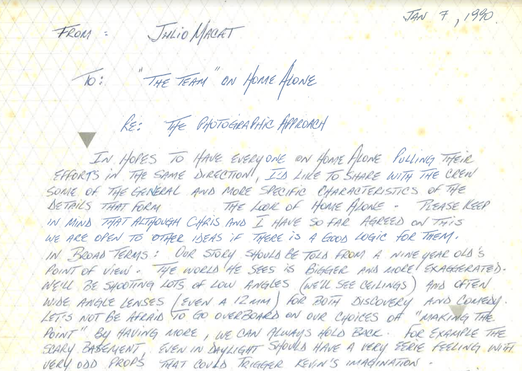 Mission statement to the crew of Home Alone. Courtesy of Julio. Mission statement to the crew of Home Alone. Courtesy of Julio. When you shot Home Alone did you have a specific color palette you worked with? We did, it was so important to me because it was my first movie. I wanted to make sure that everyone in my crew was on board with the things that we had been talking about which is something you normally don’t do, but I was going by instinct – so I wanted my whole crew to know what our color choices were, what our influences where, so I wrote this two-page mission statement and I just wanted to get everyone excited about it. I haven’t done it since, but I think it’s a really good idea especially on a smaller production where it’s all about the heart and the passion for getting everyone on the same page. Obviously, the Christmas colors were important but also, we talked about the colors of when the family flies and goes to Paris, how that would be a different world. We used a lot more blues. From the minute, they land at the airport to the apartment they’re in. we went for a much cooler feel to separate the family in a cool environment and the boy in the very Christmassy reds and greens and golds. We stuck to it pretty well. When you start controlling color, and you start doing things a certain way – when a weird color comes into the mix, it stands out – like no this doesn’t belong. It’s something that once you start controlling, it takes a life of its own. John from Chicago asks about the scene where Kevin wakes up alone and sees flashes of his family members saying horrible things to him, it looks like the actors were saying the lines directly to the camera. How and when were the shots conducted since it clearly wasn’t part of the original scene? It was in the script. It was in his imagination. What’s interesting is that 30 years ago when we did this visual effect were not as great as they are now, so everything has sort of a milky feel to it, and that’s because the visual effects dissolves they would do were not as good but they kind of worked to the favor of the fact that it was kind of dreamy-ish and felt it like a memory so we kind of went with it instead of worrying that they were kind of shitty visual effects. That goes to show you that sometimes you land on accidents that work. It was definitely shot during the movie, we wanted to distort it because to me and the director when you think of a memory it’s never clear. It’s sort of distorted, so we used distorted lenses. It was a 14-mm lens and the lighting was cooler and slightly different from the rest of the movie. Everyone was going over the top because of the idea that a kid remembers things in an amplified way. It was an over-the-top memory and that’s how we approached it visually. He’s sitting at the table and he remembers all of this and then he shifts from being afraid to being like “hey I’m alone, screw my family” and you see it in his face shift over. From there he’s happy to be by himself and jumps on the bed. Mariah from Texas asks, because there were no Go-Pros back then, how did you film the POV shots of Kevin sliding down the stairs? I found a tiny camera the size of this (holds up a newer Polaroid camera), and it was an Ari2c camera, they made a body that was tiny that they used for medical purposes, they call it the medical 2C camera, and it had a short spool, a 100 ft spool which was less than a minute. The magazine was tiny, and we used to call it bonus cam. I call it the chicken shit camera because I was so scared when we started, it was my first movie and I wanted to make sure that we got everything. We had two cameras rolling most of the time, and then we had bonus cam which was this tiny little camera which I had gotten used to using from doing stunts. I would place it close to the car driving by and interesting spots where you couldn’t really put a camera, but you could put bonus cam and then plug it into a battery, and it would just roll and get whatever it got. It was usually a good cut for an action sequence. When we started doing stunts I had bonus cam and I started putting in a place where I was afraid that something would happen in decent, and I wouldn’t catch it because both cameras would miss it. So, I would use the bonus cam as a wide and stupid shot of the thing. Just to have it, and make sure we didn’t miss it. At first, we put it on a stick and would fly it over like a boom microphone and just have an aerial which was usually a 16 mm lens. Or when Peschi was going to fall on the ground we’d just put it wherever we could and accidentally great things were starting to happen. Peschi would fall right in front of the lens or near it, and because it was so little no one even knew the camera was there. We started to see at dailies that bonus cam was getting some really cool shit. We were like oh my God bonus cam is cool! We love these shots, so then we started to think, what else can we do with bonus cam that’s kind of nutty and fun? We put it on a rope and would throw it down things, like when the iron come down. We threw bonus cam down on the rope and that became the point of view of the iron hitting him. Bonus cam became the star of the show, and we started to think about where to put our “go-pro”. Bonus cam helped to design a style of the things we were doing of big and wide and close and then translate it to other things we were doing, including the boy running up to the camera and going ahhhhhh and running away. Those were because we saw our “go-pro” was working and we started using it as a stylistic piece of what we were doing. Have you used that bonus cam on other shoots? Absolutely, when you learn something like that, any time there’s a stunt that’s going to happen, for me there’s a bonus cam somewhere. It draws you into the action. 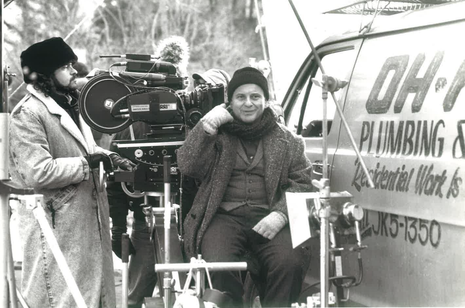 BTS of Home Alone filming outside. Courtesy of Julio. BTS of Home Alone filming outside. Courtesy of Julio. Steve from Australia wants to know what challenges did you face filming Home Alone? Was snow a problem or was it all fake snow? Snow was a problem, but like any problem you try to take it to your advantage. The very first day of filming we shot a sequence where the boy goes into the pharmacy, and he gets a toothbrush and the old man comes in, and he runs away. WE shot that whole sequence when there was a massive snowstorm outside to the point where we laid our cables and then the snow storm came in, and we couldn’t find our cables. There was a foot and a half of snow, it was crazy we had to leave the stuff behind. There was snow when we didn’t want it sometimes, but we adjusted to it, but after the big snow fall we went ahead to do the big day exteriors where we needed the snow outside, and then we couldn’t get all of our work – so when we had to continue doing those exteriors we had a machine that’s like a tree chipper, and you throw blocks of ice in it, and it shoots out little bits of ice that look like snow, so in the foreground of the scene we had real ice chipped snow and in the background of the scene we had potato flaked snow. Which is fake mashed potatoes that they blow and looks like snow. We also used foam, which looks like snow, but when the wind comes up in Chicago, we had these bubbles blowing through the shot which is ridiculous. Those were the three different types of snow. When we did the church sequence, which is my favorite sequence in the movie, it had been snowing, and I remember going to the church, and we were all waiting for the snow to stop. I remember saying a little prayer, I remember talking to the priest he was excited that we were filming at the Trinity Church, and he may or may not have given me a glass of wine, but we won’t get into that. We walked out, and the snow stopped. The first AD said we have Jesus on our side! The snow stopped and we shot it. It was a magical moment. That’s where film Karma comes in, for all the good things you’ve done in the past, you get thrown a bone, you get the right cloud, you get snow stopping, things like that. If you had to choose only one lens to use for the rest of your life, what would it be and why? Either a 35mm or a 32mm. You’d have to think about the story, you know one’s a little bit wider and a lot of people think, including Hitchcock, when you go like this (cups hands on the side of face) and you look out, and you’re trying to see something that’s very much what your eyesight is seeing without distortion, a lot of people think the 35 is that milliliter. When Kubrick used to shoot location photographs, he would insist that all of the shots be done with a 35 mm at a certain height, I think it was 8 feet. So, you had to be on a ladder with a 35 so as to not distort the location, so you can judge it just for what it is. It’s a lens that can work for a close up, and it can also be far enough back and work for a wide shot. I’m not sure 100%, but you know the movie 1917 which used pretty much one lens, it was a version of a 35 mm, and spherical, but they shot it in a 4k format, so it was close. It was close to a 35. I don’t want to say in spherical it would probably be around a 29 mm. What my friend Roger Decans shot that film with. Do you have any advice for beginner DP’s? If you’re calling yourself a DP, somewhere on that path to where you are now, you photographed something that really made your soul come to life, you did a photograph or a picture or a moving image and went “oh my god I love this”. It’s the equivalent of in the old days where you take a roll of film you shoot all these pictures, you didn’t know exactly what you got, you took it to get processed, it came back, you looked at it and there were three great surprises. Three photos that make you go “oh my god, I can’t believe I photographed this! I shot this, these are good”. That feeling that you get of accomplishment and excitement, and the fact that you captured a moment that’s passionate that says something and that made you glow, this is why you’re a cinematographer. My advice is to try not to lose that. I’ve worked with a lot of first time directors and young cinematographers, who ask me, and I always say, “you can do a lot of shots for a scene. You can do Steadicam , 360, you can run around, but if you had to tell the story and pick one shot, one millimeter, one position, if you had to tell that story in one angle, what would that be?” It’s an interesting exercise because you’re going to be in one place and often times you want to be in that place at the beginning of the scene and at the end of the scene there’s a better place to be in, but often times you want to pick the place that tells the story in one shot, and that’s the master shot. When you pick that spot, it just makes it all work. You’ve succeeded in transforming that passionate moment you had interpreting the story into a visual. That would be my biggest advice, to not lose track of the one shot that tells a story, and be passionate about it. Do ordinary things in an extraordinary way. That same shot could be as simple as a door is open and people far away are talking, and you’re seeing it from this perspective and that could be a shot that tells a story, or, there could be a keyhole, and you make a bigger keyhole, and you put your camera through it, and that’s looking at the scene in the other room. It’s a similar shot, but it’s two completely different things. The real fun of being a cinematographer is picking those little things that changes the way you tell a story. That’s the exciting thing about what we do. A lot of it can be technical, there can be a lot of time and energy thinking about what camera you’re going to use, what lens, and that’s all well and good, but in the end, it doesn’t really matter. You can shoot it with your i-phone. What matters is the shot that you’ve created that tells the story. Rather than get crazed with resolution, 2k, 4k, it’s the shot that matters, and it’s what makes us special in storytelling. Don’t lose track of that passion that makes you make that one shot. You want to have something that feels professional, I understand that but it’s amazing that Canon makes these SLR type cameras that really do look professional, but be guided not by the equipment, the equipment is just there to record. I worked with Antonio Banderas one time, he directed his first movie called Crazy in Alabama, which is another one of my favorite things that I’ve photographed, he’s a very passionate guy. I remember one time we were doing a scene and things were late, and they didn’t have the right items and there was chaos on the set – which happens a lot on student sets, I’ve witnessed it, everyone’s running around with their heads cut off and everyone’s a director. So we do this and then “roll the camera roll the camera!” and you mark it, and then there’s a silence, and then the scene happens, and then maybe some magic happens, and we cut and Antonio comes over, and he says to me in broken English, “Aren’t you glad that the camera doesn’t have any feelings?” and I looked at him and go “what do you mean?” and he goes “yeah it’s crazy, it’s insane up there, all kinds of hell is breaking lose but the camera just records what’s on the frame, it’s not affected by the fact that everyone’s in a bad mood, it just registers it”. It’s interesting that often times you can just have your recorder guided into what you really want to do and not the madness of everything else that’s going on outside of it. That’s why it’s really important for us as cinematographers to feel like the gatekeepers. The keepers of the image. There to make sure there’s not a tag in the wardrobe or an imperfection in the makeup that’s terrible, we’re there for that and that’s our responsibility. That everybody’s job, the costumes and props, everything is ruined unless the keeper of the image says hey hey hey look at that, is that what we want? Without embarrassing anybody, but things happen on a film set. That a fun part of it. The pandemic has impacted a lot of the film industry, set protocols, movie theaters being shut down, streaming, and everything else, what do you think the future of filmmaking is? Being on a film set, you’re always adapting. You’re always changing to get to the other side of the problem, we’re problem solvers by nature. Of course, we’re going to figure out if everyone’s wearing masks and everybody’s testing we should be able to get back on set and be safe. We’re safe when we’re doing stunts, were safe when there’s 20 gallons of gasoline and there’s going to be a tremendous explosion, and you have four cameras in the vicinity of it you’re going to figure out how not to kill people – so it makes sense that we would be smart enough to try to get around it. I’ve had three different projects fall apart unfortunately because of COVID-19 and it’s sad, but we will come back to normal eventually. I’m dying to get back to the theater and see something as it was meant to be seen, on a big screen. I hope that people don’t forget that experience, because when we’re making a movie we’re creating the experience not to sit at a monitor or a little screen – it’s not the experience that we love sitting in a movie theater. We’ll get back to it in a year or so. We have to shoot for that though. We can’t all of a sudden become these Quibi people that are going to watch our work on a cell phone. I hate that, an image is meant to be projected, and meant to be shown in all its glory. Everyone’s effort from the wardrobe to the makeup to the hair stylists to the set design, all of it is appreciated on a big screen. We shouldn’t lose strike of it, and we’ll get back to that, but it’s going to take some time. What’s next for you? I don’t know, I’m reading a script now, and it’s possible, we’ll see. I don’t want to jinx it. It could happen in March – I’m kind of gun shy because I prepared three movies and then the week before, one of them the actor didn’t want to commit to it because of COVID-19, the other one it came to the conclusion that it was too expensive to do all the proper COVID-19 testing and the budget couldn’t accommodate it, and so I’m open. Maybe you guys will write something amazing and send it to me. Anything is possible, shoot high. You don’t get a second chance to make a first impression. If you’re going to send a script to someone make sure it’s the very best script you can write. That person could say, yeah I’ll read it. It’s got to be good because that’s your shot. MY other recommendation to other filmmakers is before you roll that camera before you finish your project, ask yourself “have I done everything I could possibly do to make this something that excites me or that I would want to go see?”. Don’t just do it as an assignment, do it as if it means everything, because it does. If you want to be in our industry, the people who don’t survive are the people who are washing dishes with lukewarm water. It’s the people who have to work with hot water – you want to go for it, you want to make a statement. You want to make it count you want people to remember your work, so it shouldn’t be half assed, it should be the very best you can possibly do. The beauty of this industry is you have 100 years of history of amazing movies, you could go back to every movie that won the Oscar for the next 50 years and really from those there’s something that’s going to speak to you. Whichever movie you picked, there’s a reason why you loved it and there’s a reason why that may have something to do with your taste and developing your taste. If you love that, maybe do your version of that. Look at all the great stuff we have as background research. The American Society of Cinematographers is 100 years old. 100 years ago some dude figured out that you can pass film quickly through a gate and get an image and here we are trying to do the same thing. Well it better be a good picture, somebody worked their ass off to figure out how to make movies. Set your sights high on your projects and I think that we’re all storytellers and the more that you’re influenced and the more passionate you are at telling your story the more that you’ll be guided in the right direction.
0 Comments
By Meg Moore Bridget interviews Amanda Hanna-McLeer, the Post-Production Supervisor of 'Broad City' and 'High Maintenance', who also writes and directs in her free time about mental health in the film industry and protecting your boundaries. I just wanted to say how grateful I am for someone to be finally writing about this, 14-hour work days and overnights definitely have an effect on one’s mental health. Thank you for joining us. That’s something I’ve been wanting to write for a really long time, and it’s difficult to write something like that while you’re working. You don’t want to offend anybody, you don’t want to rock the boat too much because you know, in this industry especially, that your job security relies on who you know and networking. I had written drafts loosely of something like this in the past, on particularly bad jobs, and then when the pandemic hit, I thought I have no one that I’m accountable to right now. This is the perfect time, especially because I had a feeling with the pandemic that we’d be asked to do things that were not safe. I’ve been asked to do them in the past, I’ve been asked to overwork myself and give up personal time for my job, and with the pandemic that can only be exacerbated. I felt it was really crucial to get it out at the time that I did. I had actually written it early in the pandemic in April and I had been pitching it, sending it out to people and it didn’t get noticed in Current Affairs until June. Even then it was still timely, I still had things I had to adjust. We were seeing as I mentioned in the article, that film crews and film workers were being used as guinea pigs for how to go back to work, and that’s unacceptable to me. It was the perfect time to start to talk about it, think about it and reflect on it. I had coworkers who were always very career driven, and I am myself, but I also would try to steal people away for lunch and I live in New York City, so I’d say “Let’s go to Bryant Park for Lunch, get away from your desk, that is so unhealthy” and some people were really hard to convince, but when all of this happened those same people reached out to me and said “oh my gosh I’ve completely realigned all my priorities, and I’m so glad I’m seeing what I was missing out on when I was working those 12, 14-hour shifts”. You discussed in your article being over worked for someone else's enjoyment was normal before the pandemic, do you think executives and showrunners will change their perspective on these horrendous conditions after the pandemic? I would hope that they too benefited from some free time to reconsider their priorities because they are also over worked. It’s this hierarchy, there's the studio, there’s the showrunners, and everyone has to answer to somebody else. It can be difficult, especially when timetables are crunched, with our short attention spans, the prevalence of fast media everyone wants to get things out really quickly. I think it’s more likely, in order to change things for the working class of the film industry, people that represent most of the industry that keep it running, like myself and my colleagues, that if we set the standards, with the help of unions, but also with solidarity and letting each other know that this is no longer acceptable, communicating with one another and then putting the pressure on our employers to do that, because I think it’s really hard to wait around and expect somebody who’s not on the ground with you every day, or with you in your apartment when you’re waking up at 9 in the morning and answering emails on your phone or with you in those late nights, it’s really hard to convince them that things need to change. Also considering that people who are higher up have been in the industry for a really long time, and they’re accustomed to the way things are, and they don’t really have any incentive to change it because they’ve benefited from it. It’s challenging to get them to shift. That’s the thing that’s really important to remember, there’s this yearning to go back to “normal”. It’s a very scary time for a lot of people, they’re either unemployed or they’re working in conditions that are not ideal, so they’ll yearn for that normalcy but it wasn’t really normal before. Normal wasn’t really working. I’m hoping that when we do get past the pandemic, people remember that they enjoyed spending more time with their family, or finding hobbies to rehabilitate or find new ones. I hope people will strive for a better work-life balance.  List of film unions from Google. List of film unions from Google. What do you think us as filmmakers can do about this? The big thing that I’m working on right now is unionizing. If you’re not part of a union, try to look into ways to unionize, it’s really essential, our labor union has been gutted for the past few generations, you can date it all the back to the red scare, the black lists; I think it’s important to find community and reach out and talk to people. One of the issues I had when I was working on these shows and working crazy hours is you feel pretty lonely and you just assume that everyone else is doing it and that you’re the only one that is having an issue with it. But once I started talking to people it was miraculous, I talked to other supervisors like myself, and they were feeling the exact same way. I not only had an outlet to vent, I also had another person to go “hey I’m getting paid this on that show, that doesn’t seem right. What are you getting paid?” and they would say “Yeah that doesn’t seem right, I’m getting paid this”. It’s about sharing that information and not creating this culture of fear or nervousness about pay transparency, we have to be transparent about what we’re being paid in order to move forward and demand better rates and conditions. If we don’t, we’re just kind of in the dark and we think what we’re going through is acceptable, so that’s a huge thing, community building and talking. Weirdly social media has been really wonderful in connecting me to people who are not just in my inner circle in New York, but all over the country. That’s the biggest thing, just talk to your fellow humans. 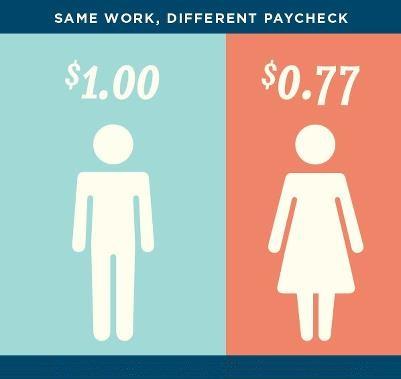 Image showing age gap between men and women. https://www.kvcrnews.org/post/equal-pay-day-calif-women-work-close-gender-pay-gap Image showing age gap between men and women. https://www.kvcrnews.org/post/equal-pay-day-calif-women-work-close-gender-pay-gap There’s a lot of inequality with women getting paid vs men in the industry. Absolutely, and in post a lot of the administrative positions are filled by women, so it’s a bunch of women who have been taught to accept what they’ve been given, not question it too much, but there’s also power in that kind of sisterhood you can have and I’ve seen that on several shows. But all issues of pay disparity affect everybody, I’ve talked to several coordinators and supervisors that when I ask how much are you being paid, we're being paid way under what I thought they were on major network shows and so really it affects everybody. You brought up that most filmmakers are non-union, meaning they have zero benefits, but they have longer hours that they don’t get paid overtime for, what do you think is the solution to this? I think people should go and see if there has been union efforts in the past for their specific role and look if they can start up one, I think in the meantime if you are not unionized you have to start advocating for yourself and advocating for your colleagues. I had an interview recently and I asked for the rate that I thought I deserved, it was more than I had gotten in the past but when you start negotiating that way that means you’re setting the bar higher for the next person that comes up for that job interview and if you’re then transparent if they're going in for that interview, you can tell them this is what I asked for this is what you need to do. There’s plenty of things we can do, even without a union to protect ourselves. For post supervisors, we typically have 60-hour weeks which is insane, it makes no sense, you’re supposed to have a 40-hour week, how are we at 60? The thing I learned recently is that it's not required, I can negotiate that when I go into an interview. I can ask what the hourly requirements are, they can say 60 and I can say, well that’s cool, I want 50, and even 50 is above the 40-hour work week we’re supposed to have. Knowing things like that, educating yourself on labor movements, the history of them and what has happened since then. A union is wonderful but people find loopholes around a union. I’m fighting for one now but I’ve seen abuses on union sets, so it’s really important to have a union and use it and to make sure that your voice is heard within your union and to have backbone in asserting those things. It can be hard because this is an industry where you get your job based on how well you do on your last one and you have to network in order to know the right people, so you never really want to cause too much of an issue - but you have to do it for yourself and think of yourself within the larger community. Where does one begin about joining a union? There are people who have been in the industry for a really long time who are not union, there are editors fighting to be a part of the Motion Pictures Editor Guild, and it can be really hard if you don’t have those contacts to get on a union show. Some shows I’ve heard in the past flip union and then the people who get into the union that way are extremely lucky, it rarely happens, otherwise it’s connecting through the right people. It can be really challenging. Post supervisors don’t have a union, so when I wrote the article one of the things I called for was that we need to be unionized. There were some options, you can either create your own union that is unaffiliated but that’s really challenging, it’s a lot of work, or you can look into an existing union and ask, would their union benefit from my membership, and how closely aligned are my duties and responsibilities with this union? For my role I oversee editors and assistant editors, I couldn’t do my job without them, and they couldn’t do their job without me, so I had to think about that when I was appealing to the motion pictures editors guild and for me that made sense to start this effort and appeal to them. That isn’t always the case depending on what you’re doing in the industry but in that case it made the most sense to do it that way. It’s all an uphill battle, it takes a long time, organizing takes a really long time. At the beginning of it you don't know how efforts are going to go. We’re appealing to the motion pictures editors guild, we’ll see how that goes, but it just felt really important to do at this specific time because no one’s going to advocate for us, we have to start advocating for ourselves so that maybe someone can take on our cause. 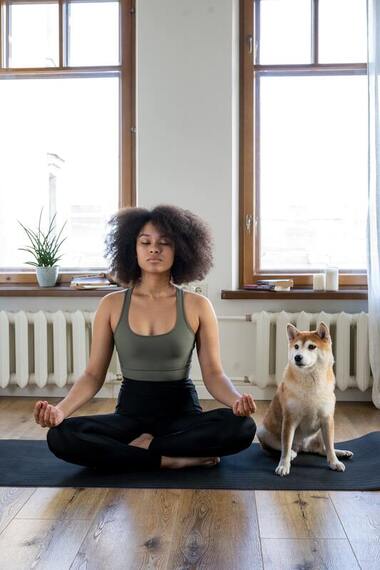 Woman meditating with dog. Photo Courtesy of Cottonbro Pexels.com Woman meditating with dog. Photo Courtesy of Cottonbro Pexels.com What can filmmakers do if they are experiencing burnout? What are healthy ways to deal with stress? I’ve run the gamut of trying to find the answer for that over the past couple of years. For me it’s exercising, for a lot of jobs in the industry you’re stuck behind a desk all day staring at the same thing, you need to take breaks. If people won't take a break for lunch, that's the first thing they can do. If someone’s working right now, and they’re feeling stressed and overwhelmed, take the break for lunch, leave the office. There’s this culture on some shows I’ve worked on where everyone sits together and eats lunch together in the office still and that boggles my mind because everyone just starts talking about the show and the job and then lunch breaks and you’re back on the job - so it’s not even a break, you’re entitled to that time. Whether it’s 45 minutes, whether it’s an hour, you need to give yourself that break, you’re not accountable to anyone in that time so you can do whatever you’d like. That’s huge. Green space, getting into a park, anything, is super important also. I would drag my coworkers to Bryant Park and just sit for a second, it’s so funny because some were with it, and others would check their phone, terrified that they would miss some email, some call, from someone. If you can’t take this hour when you’re working all day, what are you doing? Breaks. Also, putting your foot down when you’re not getting paid to do extra work. Don’t do the extra work. I was talking to someone recently who’s a production assistant who’s also a coordinator who was doing two roles for one rate, which is obscene, and they’re working on the weekends without getting paid, and it’s so common that it happens, but it’s unacceptable, and I was telling them don’t do the weekend work, you get an email, ignore it. That’s what I did, I would get emails on the weekend all the time and I would ignore them, because that’s not their time, this is my time, especially when so much of my time is taken by that throughout the week. I explained to this person that despite doing that, despite setting those boundaries on the weekends at a minimum, I was still asked back to shows, I still was able to secure jobs on prime time television. It’s not something that is going to threaten your future work opportunities. The same goes for the weekday, it’s unacceptable that we’re still going home and sending emails until the middle of the night, or that anyone would expect that of us. On some shows I would wake up and before even getting out of bed I would check my email because there was some urgent thing that I would need to resolve before I even got up to brush my teeth. That’s not a life, we can’t do it. Put your foot down, don’t work when you’re not getting paid. It’s one of those things where it’s like “obviously I wouldn’t work and not get paid” but it happens so much, and especially for people that are starting out in the industry and are eager to please and get their foot in the door. It’s tough. I read that your primary goal is to become a director, we need more female directors in the industry of course. What’s next for you? I think the figure is somewhere around, 8% of the top grossing films are led by women directors which is crazy. That’s the thing, as much as these companies say that they’re committed or these productions say that they’re committed to hiring female filmmakers, I don’t know how they deliver. They don’t always deliver on that. It’s challenging to get your foot in the door and get recognized. Some of the things I’ve done is, I made a film, Brighton, I fit that into a two week span where I had some free time in between post jobs, writing on the weekends, that’s the thing! You need that time on the weekends to do your thing because post was just my job, I saw it as just a job. My real focus was directing and writing, so yeah, just fitting in that time was really essential. I made Brighton, I’m pitching a series right now that I wrote, a 10 episode series that I’m very excited about. I was accepted into IFP in 2019 for. IFP is an independent filmmakers project, it’s like a speed dating for filmmakers where you can pitch your project to producers in the industry. I’m working on that but the pandemic of course throws a lot of that stuff. I’m trying to find my footing again with that, but finding work when I can, writing because I don’t need a full film crew for that so that’s really nice. Last year I had a really wonderful experience, I’m on a New York Filmmakers group for women, and someone had posted about a project that was being shot in Amsterdam and New York and I thought this was surely fake but I’ll apply to it anyway and it ended up being a very real project, and it was my first time directing anything episodic, it was a web series. I flew out to Amsterdam, and we flew back to New York. We got to work with Catherine Curtain from Orange is the New Black which was really cool. I try to find directing opportunities whenever I can. They’re really hard to come by, it was the first project that I hadn’t paid for myself or written myself and put all that producing time into. That’s why it was a really interesting experience. That’s kind of where I’m at right now. Those opportunities don’t come by that often, so I do hope that we can pave the way for more opportunities like that. Where can people find you? If anyone wants to reach out DM me.
If you’re going through anything, if you’re having a tough time at work or you feel like you’re being exploited at work please reach out to me, I am very open to talking about that stuff and figuring out a way to help you take more control over your workplace. By Meg Moore 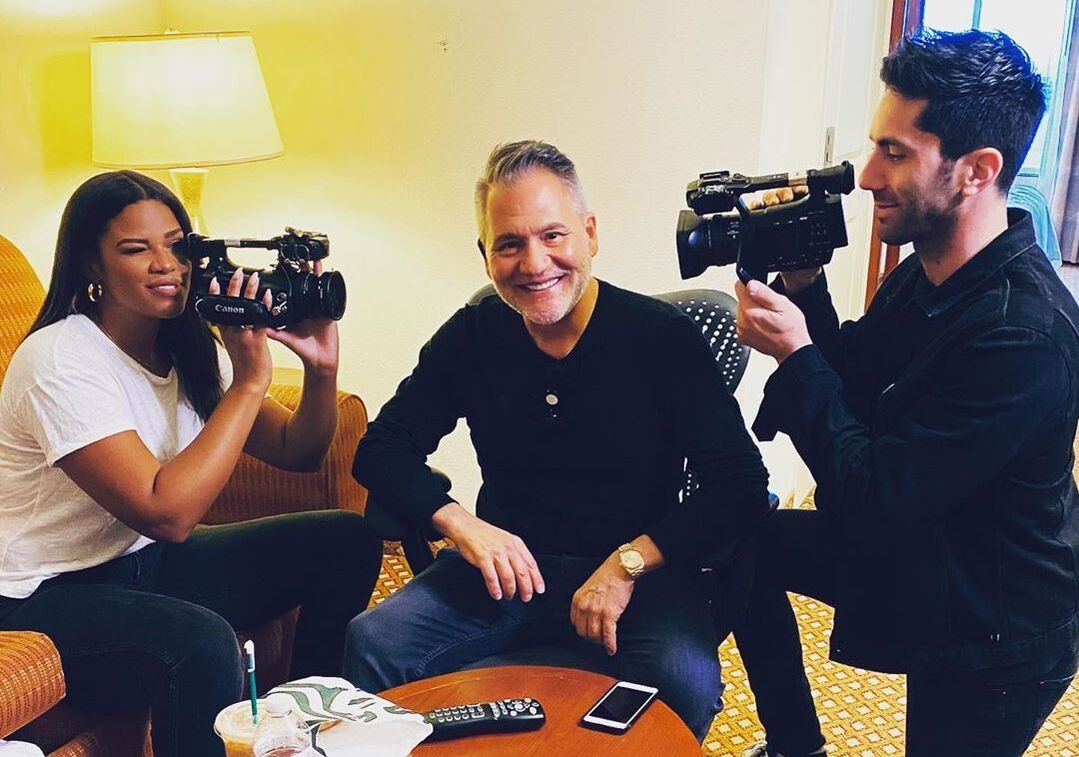 Hosts of MTV's Catfish Nev Schulman and Kamie Crawford film DP, John DeTarsio. Hosts of MTV's Catfish Nev Schulman and Kamie Crawford film DP, John DeTarsio. Dare to Dream Productions Podcast, director and host Bridget Johnson interviews the director of photography for MTV’s tv show, Catfish, John DeTasio. He speaks on how cameramen adapt to filming up close reality content in a pandemic. He served as the executive producer of creative development at NBC and was the DP for many of CBS’ 60 Minute segments. He’s a freelance cameraman and has been the DP on all of the seasons of Catfish. This University of Arizona Graduate also has experience with producing and directing. John’s interview has been edited and condensed for clarity. Watch the video version here. How did you land the job being the DP of the show. Did you work with Nev before? I had not worked with Nev before, but I was a fan of his documentary. I had seen that two years between the time that the documentary came out and the deal was done with MTV to make the pilot, when I got involved. Many things had to fall into place as you’ll learn the more and more you get into this business. Every relationship you have in the world you leave in a good place because you never know when they’re going to come back. I was aligned with the CEO of the production company that makes catfish for MTV. So MTV agrees on having a show, they hire a production company, and that production company boss I knew from back in the days when I did a lot of 60 Minutes and 48 Hours, he was a news producer. So he knew me as a magazine documentary guy. The person I told you about Tom Forman the CEO of this company had found David Metlzer, who had a very successful show called “Queer Eye for the Straight Guy”; the original one. He was known as a documentary real life, not “fake reality” but “real, reality” producer. I was connected with David through Tom, already we had been working on a few shows together. When Catfish came along, they just saw me as a really good fit, because of my background in news and documentary news magazine, along with my body of work. They felt that I was the right person because I really wanted to make an original real, reality show where you are discovering things as they happen and you walk into doors one time. You don't set up, you just go on intuition and the energy of where things are. They felt that that was my strong suit and that’s how it happened. We all kind of came together, we always say it was lightning in a bottle, we all kind of found each other accidentally. I’ve been in this business a long time, thirty-something years since I've graduated from college. I’ve been on many shows and I cannot tell you how rare it is to find a show that even gets out of the pilot and becomes a TV show. You’ve already done an incredible amount to just get a season of TV and then to make it two seasons is unbelievable. Never in my career have I been so lucky to be on a show where the core group of people are still the same, and we’re now 9 years later and 160 shows in. It’s been amazing, we take every day as a blessing, we just appreciate the fact that we’re still doing it, and we feel like we’re making a good show and in our way trying to send a good message. Even though the people on our show don’t come from the best positions, they’ve had a lot of struggles but everyone is a human being and that’s what we’re really proud of telling. You helped so many people find their love life with their lover that they’ve been searching for for years and not even talking to them on the phone. We still try to keep in touch with as many of these people as we can. Nev’s always receiving text messages from people from the past. Despite the limitations of not being able to travel to meet the catfish, and doing it on Zoom instead it was still highly entertaining. So what challenges did you face as a DP filming this show during the pandemic? If you were to direct a show and you can't speak or a camera person with one arm tied behind their back, it was very challenging. Like everybody else when the pandemic first came out everyone was scared, we all retreated to our homes and waited to see what was going to happen. It took a month, maybe longer when our executive producer and Nev and Kamie were all thinking “you know what, as many catfish there are in the world I would imagine there’s even more of that right now”. People are just stuck at home, people need to talk to people - we should see if there are still stories out there, so they kept the casting going and sure enough they’ve been able to find some really interesting stories. 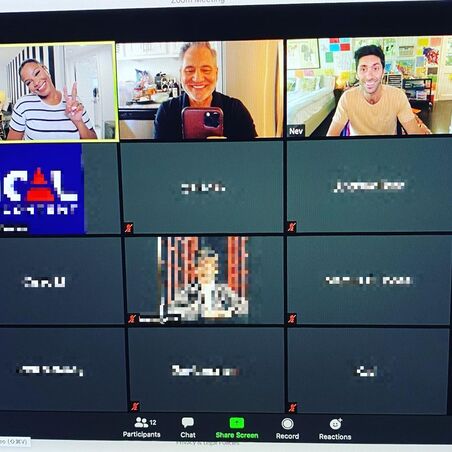 Zoom set-up for filming Catfish. Zoom set-up for filming Catfish. Zoom has been our savior, our ability to talk to each other and see what’s going on in real time. We send computers out to Nev and Kamie with software that we can control. We send a couple of small cameras to have as wide shots and through zoom I can explain exactly how I’d like to have the shot, and we can Facetime, and they can show me the shot, we did a lot of communicating like that. Our sound man has been able to find zoom recorders that take time codes, so we can sync the pictures to the sound so it’s editable. We found a way to do it. The main thing is having the software where my computer can talk to everyone else’s computer and our techs are able to make sure things are being recorded and that we get all the footage. The task gets more monumental because on a show like this, even though we wrap it up into a nice 45 minutes, one of our meetings might take four to five hours. So that’s a lot of footage that we need to group so that our post facility can gather that up and match where all the cameras are because we don’t have the ability to sync everything together like we do when we’re in the field. Bridget: It seems like a lot more work. Lots of challenges, you don't want to hear all of them. Our lives depend on good internet. It’s been quite a challenge but I’m so proud of Nev and Kamie, they’re amazing, and our post team who, even though we’re just sitting at the computer now, have found a way to still keep it so lively and interesting and I’m really impressed. It’s a small show and it looks like a small show but it’s a big family. Every stage of the way it’s impressive. 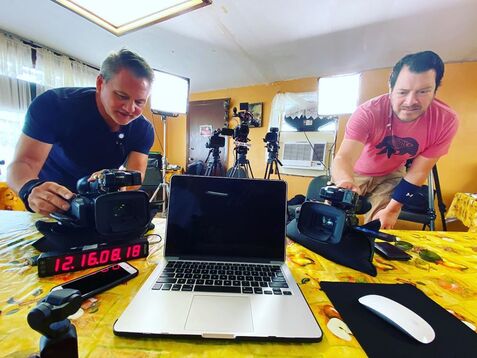 Catfish camera set-up before the pandemic. Catfish camera set-up before the pandemic. What did the camera set up look like before the pandemic? How many cameras and what kind? Before the pandemic I would travel with no less than 11 cameras. The cameras would range, A lot of point and shoot cameras that happen to shoot video. We started doing that very early on because Max was on the show with us - and Max and I were shooting basically everything. It’s hard to get all the angles one time through. Even though Max was just holding a little hand held camera - the intimacy he got from a person that was talking to him was an angle that was physically impossible for me to get unless I’m in the shot the entire time. We loved it and post loved it, and we really started to use those cameras a lot. We don’t use them as much anymore but I still take a couple of those, Kamie uses it quite a bit. I carry these little cameras (Cannon XF-205) , you can't even buy them anymore, because I think they came out in 2012. I love the camera because you have all the controls of a real camera, zoom, focus, iris control you can make it professional or you can do automatic audio settings. Kamie can take it and put it on her lap or walk around during one of our reveals like this on automatic controls, and she’s going to get something. She’s going to get an angle with the catfish looking right at the camera which we love - the raw intimacy is important to us. I also use C300 Mark II for when we’re sitting down. This is between the two (Canon XF705) which is a documentary camera, and we have five GoPro's. The reason why I have so many cameras is our show depends so much on someone's reaction. You don’t want to miss those moments. With less cameras you run the risk of missing things. We don’t do anything twice. Early on in the show I would sit in the middle and Max would shoot with his camera and it would be hand held and energetic and good, but we were missing a lot of so I added more cameras. A typical scenario is we are going to meet the hopeful, I might go to a set early and figure out where they’re going to sit, do some basic lighting, and drop off the cameras, but I don’t meet the hopeful (someone who writes into the show). We rig the car with GoPro's and then we’ll go back to the hotel. So when Ned and Kamie have their call time, they are already on camera - we follow them from the lobby to the car to the location. Me, my assistant camera, camera tech all hold the little cameras and walk into the house at the same time. We do this because we want Nev and Kamie to be part of the story. We don’t care how dirty it is, our biggest goal is to get the real reaction the first time, and we get all the honesty we can. No one actually meets the hopeful until the first day. We’ll roll the go pros and record their real goodbyes. That’s how you get real personalities and reactions. It’s complicated but it’s simple.
A little bit of control - still not as much as I’d like to have. That’s what just happened to your camera, I saw you move and the iris went up and the light changed. That’s what happens with these cameras; they're not professional cameras but at least we have a little control with them. I wish there was a way that if I were in control of your camera, I’d have some ability to pan, and tilt and zoom. There are cameras like that but you would have to be out in the garage not across the country. That would give me a lot more freedom but that’s why I have the other cameras locked down in wider shots for when those real moments happen. When you were on set during the pandemic did you have to get tested before and wear a mask? There was no set, our set was in the office, we sent them the equipment and taught them how to set everything up over zoom. But if I'm seeing Nev or Kamie we’re wearing masks, getting tested, taking all the precautions. What do you think the future of filmmaking looks like post pandemic? I’m still hopeful that we’re going to find our way back to each other. It’s not going to be overnight, it’s going to be a slow roll out, but I’m a history buff, and looking back through history we’ve had several pandemics, they’ve always subsided, and we’ve always come back together. We’re tribes people, we need each other. It won’t be overnight, I think it’s going to take a while, at first it’s going to be difficult shooting films, you're not going to find lots of extras in the background. People are going to have to write shows that don’t have big crowds. There's going to be scripted television where you go in, set up the shot get everything ready and then leave when the actors come in except for maybe two or three people, and they’re spread out pretty well. You won’t have all the crew and video village in the studio anymore. Slowly but surely as we get a handle on this and we get the vaccine, and the noise settles down and it becomes less deadly we’ll make our way back to each other. I believe that, I feel that. My son works on a reality tv show where they shot it in a bubble, it was very successful. The show basically bought up an entire resort, so the crew slowly arrived, got tested, quarantined, and nobody saw each other and finally, after all of that and time in quarantine they slowly got together and started building the show. There was no coronavirus, they shot the show for two months, at this one spread out location and it was very successful, they're planning on doing the next season very shortly. We’re all finding our way, I think the small shows are going to do okay, shows like Catfish because we don’t have big crews. MTV is being very cautious. When MTV is ready we’ll get Nev and Kamie back together in the same room. Maybe sitting a little further apart but that would be lovely seeing them together. Meet our people out in a park and stay outside and stay distant, we’ll find our way back. There are 20 of us on the Zoom associated with the show and at the end of our meetings Nev has us turn our cameras on, so we can all say hi. Do you have any advice for beginner DPs? There’s so many different avenues for DP’s, pick your lane. Really try as early as you can, what you really like, identify it. Are you super interested in multi camera sitcoms? Are you interested in films? Are you interested in taking over the corporate world? The YouTube world? And really focus in on that world and who the leaders of that particular lane that you pick are. Pick your path the way they picked their path. Obviously the easiest way is to go to a very prestigious school that hands out really amazing internships, and apply and win a great internship and go work for Martin Scorsese, that would be wonderful, but those things, that’s very rare. So you just have to pick your lane, really study the people you admire, how they did it, and learn from that. You don't have to follow their path - but learn from how they did it. You have to get to where the business is. I went to the University of Arizona, I had to find my way out to the west. still to this day there’s not a lot of work out there. Now I can go live there and commute after 35 years of connections, but I had to find my way and immerse myself in the world. Fall in love with story telling more than falling in love with your ability to shoot a gimbal shot or get nice lighting on a car. You have to know light, light is so important to know. Not just typical key light, backlight, accent light, actually study the light. When you’re sitting outside by a lake and you notice you feel really good, think about the light. When you’re looking at art and it makes you feel a certain way, think about the light. You can light with one single lamp, it might tell a story. You don’t need big toys, but obviously, understand the basics. Wide shot, medium shot, reaction shot, and understand the basic building tools of building a story. When I look at audition tapes and it’s just one beautiful shot after another, it really tells me nothing, I want to feel something when I watch. I want to feel stories and I want to feel that you understand story, you understand emotion, that there’s a person there. That directed or feels these shots. It’s not all about “look at this great drone shot I got”. 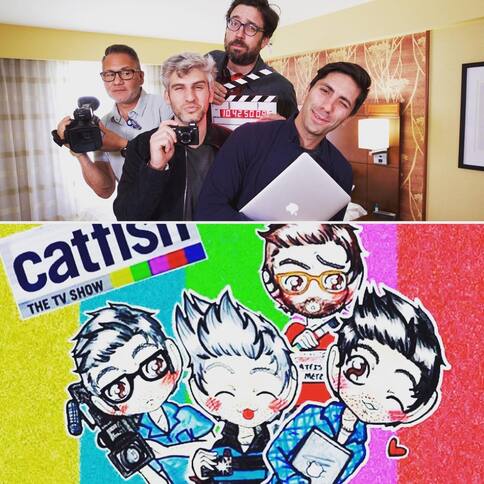 The magic behind MTV's Catfish. The magic behind MTV's Catfish. What’s next for you? Retirement hopefully. I figure I’ve got about ten years left in this business because I still enjoy it. I’m a freelancer so my life is still concurrent, I work for this company critical content, because of Catfish they have basically booked me in chunks at a time. They’ve got a lot of other projects going on, so I’m always working on other things. In fact this week and last week Catfish is dark, and I am working on a show with Kevin Hart who is doing a game show for E, called Celebrity Game Face, it’s also kind of a virtual show. Since COVID-19 our Catfish team has done a special for CBS, sort of shot in the virtual style Catfish episodes. People giving each other haircuts while we were at home in lock down. I’m out there doing other stuff but catfish is my main stay. I hope that Catfish continues on for a while. As I tell my friends all the time, us core people who have stayed with the show, we’re going to ride the wave all the way to the shore until MTV says okay it’s time to close the doors. We’re enjoying it. As far as other work goes I don’t really worry about that so much, but I’ve earned that. I’ve been around a long time so when I become available I know a lot of people and I can jump onto something else. I don’t have the big aspirations of “I need to shoot a feature film” because I’ve achieved everything I wanted to do. I’m not in it for any kind of attention, I get to direct shots, I get to pick cameras, I get to pick how the whole construction and the mood of the project is. When I was doing that on two minute news stories I was already happy, I had already achieved what I wanted to do. As different shows come along that’s great, but I’m just grateful that I get to do that. I get to manage a team, whether it’s two people or fifty people. I’m managing a team and trying to construct something for the visionary for the director or for the executive producer, trying to imagine what they're imagining and trying to bring that to life. It doesn’t matter if I’m doing it for something big or something small, I just enjoy doing it. I don’t think about what’s next, I just want to keep doing what’s now. Follow John DeTarsio on social!
|
AuthorBridget Johnson is the president and co-founder of Dare to Dream Productions. She writes and directs thought-provoking films that inspire others to follow their dreams. Archives
March 2021
Categories and authors
All
|
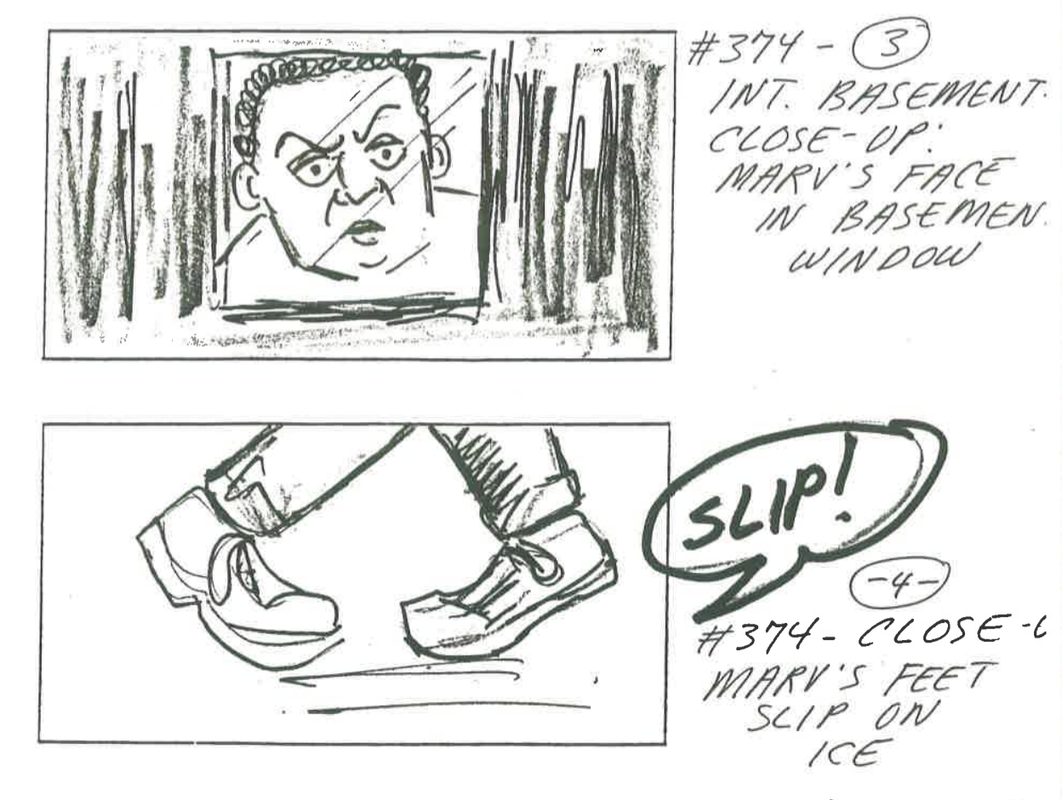
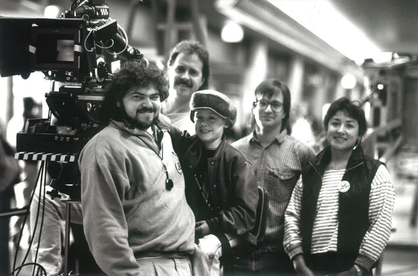
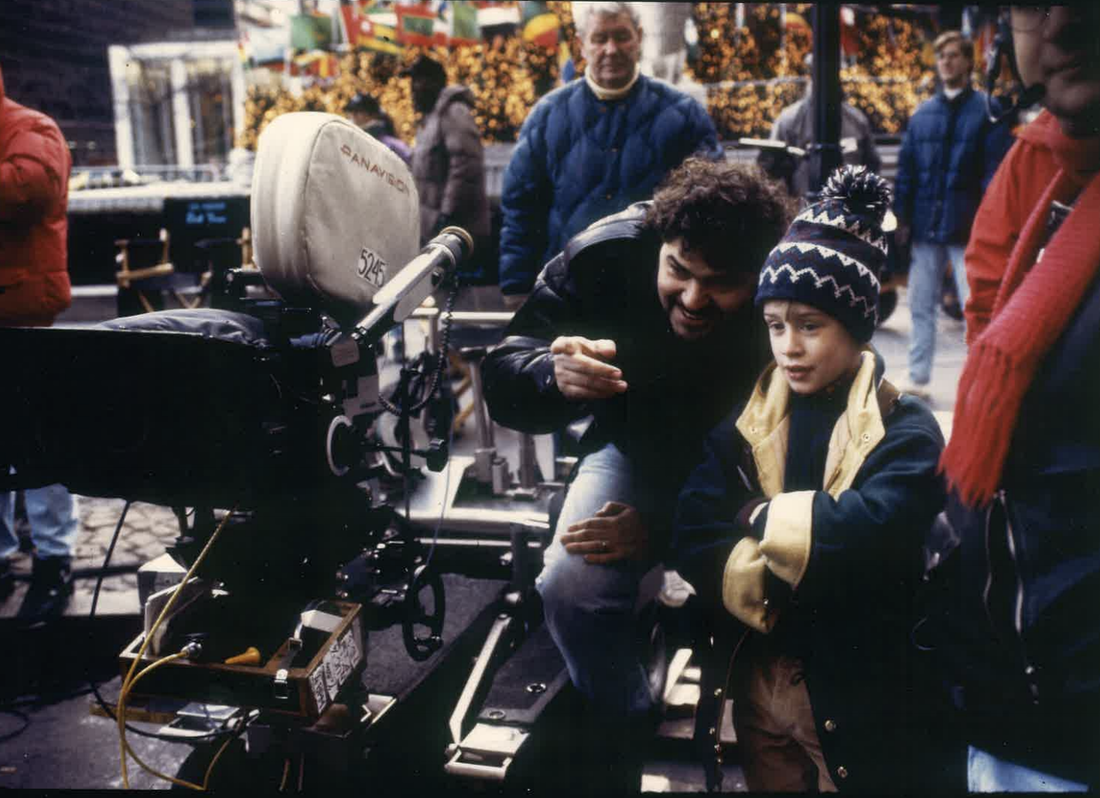
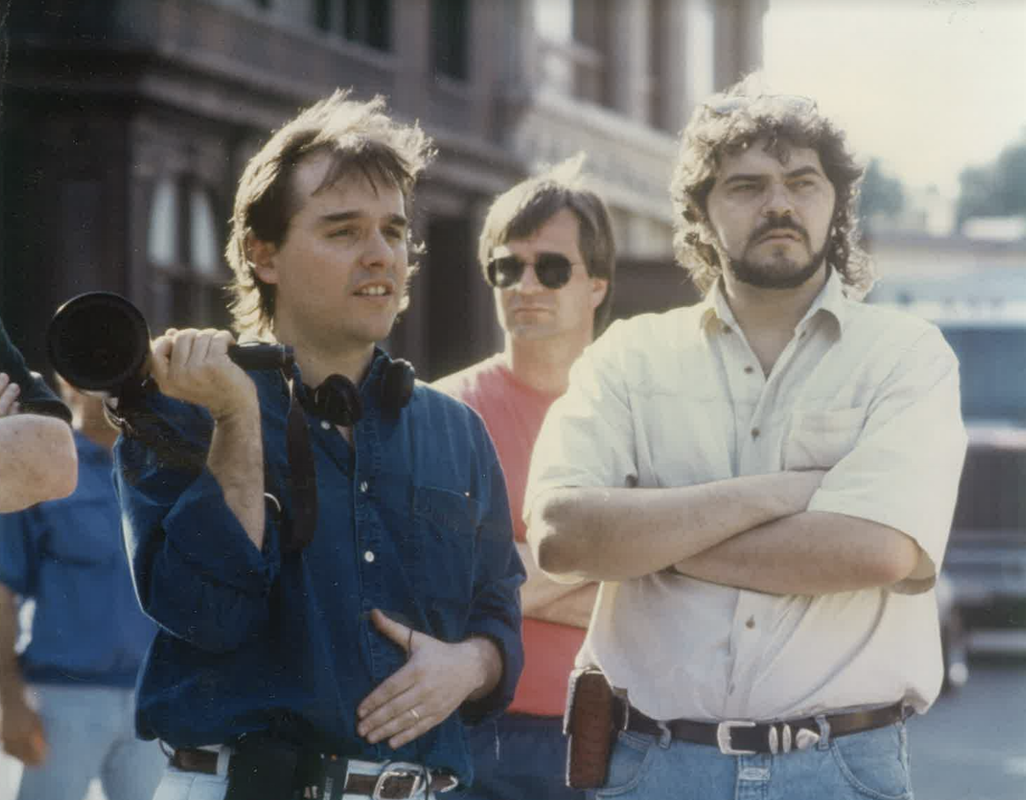
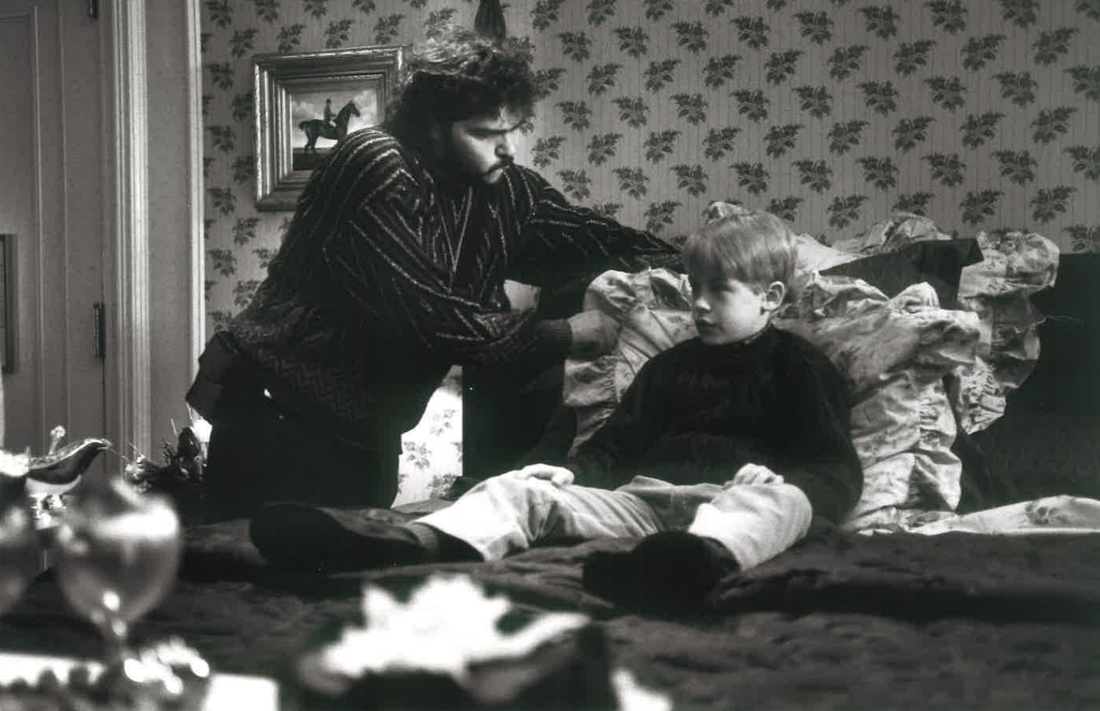
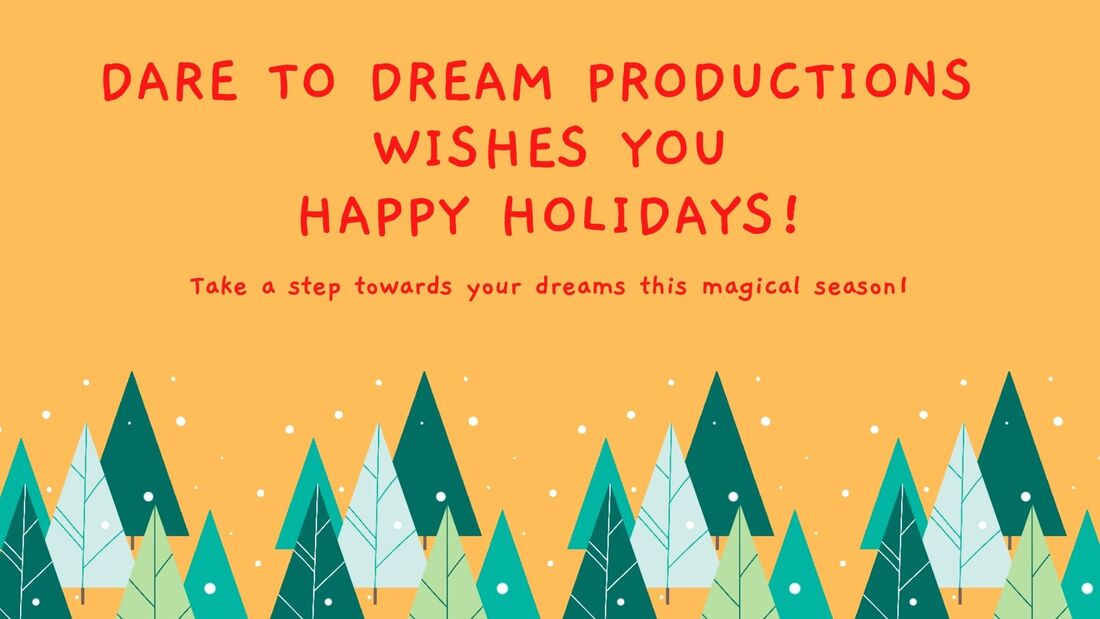
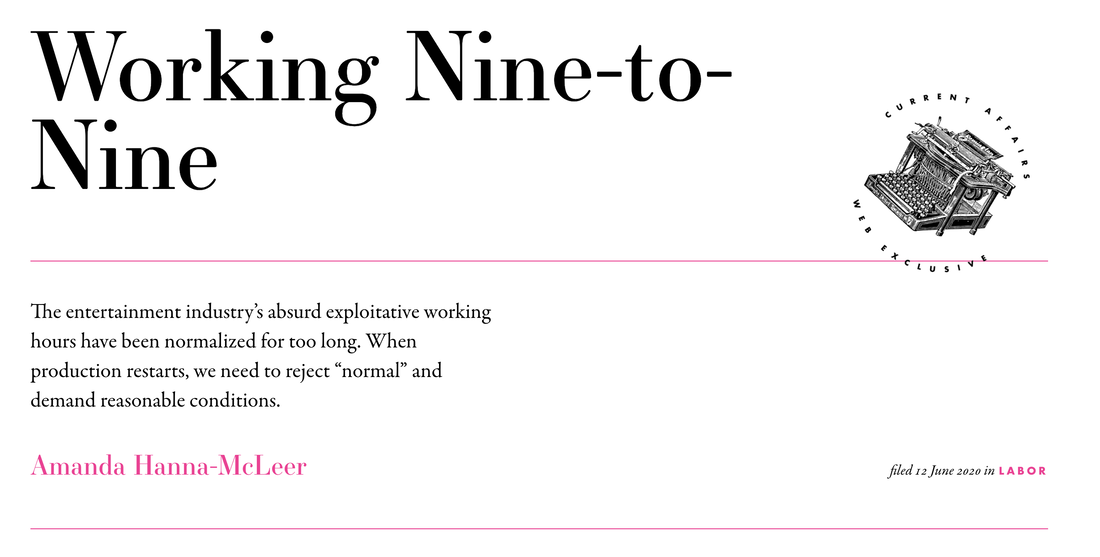
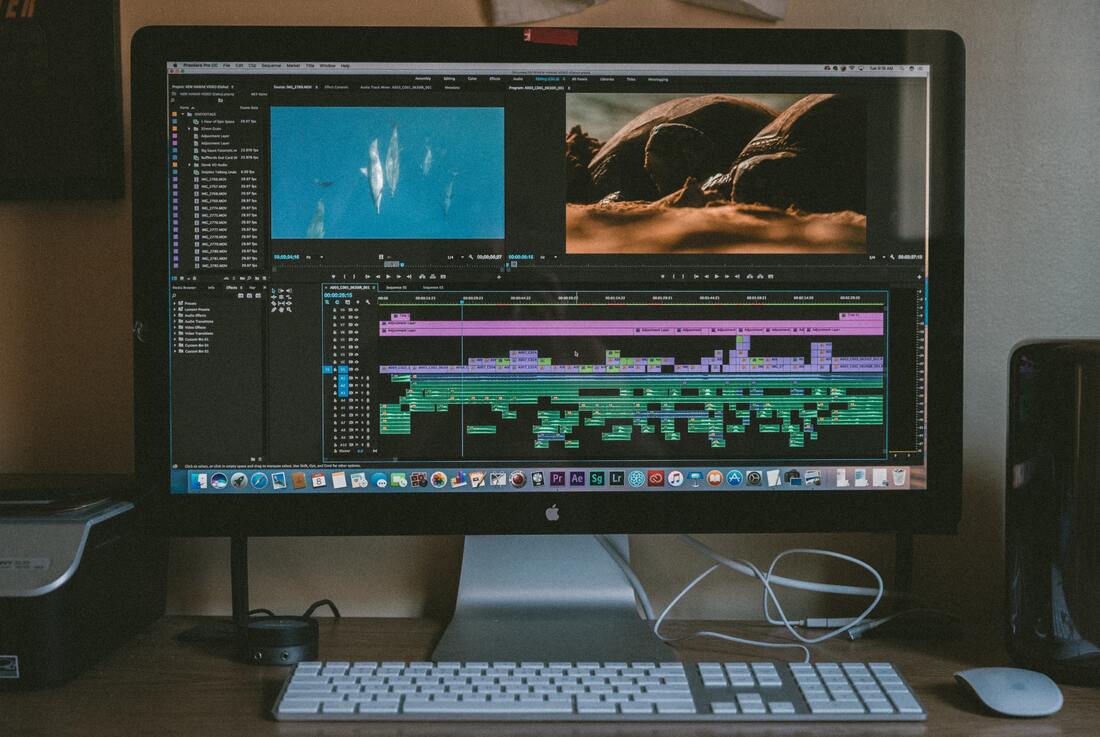
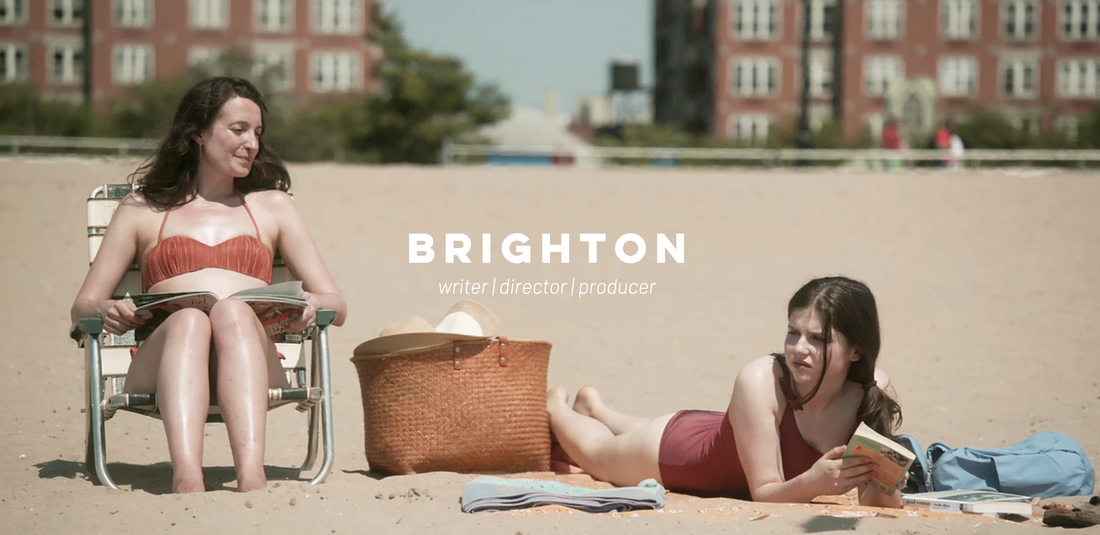
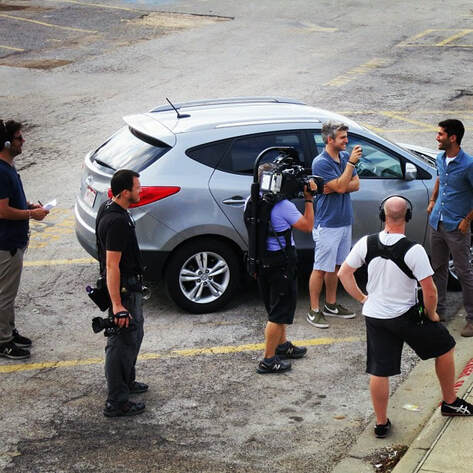
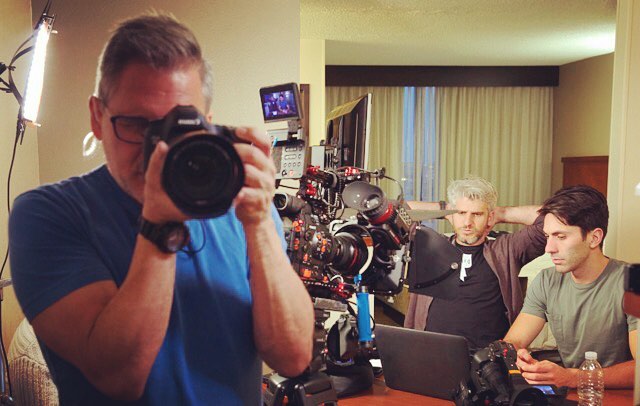
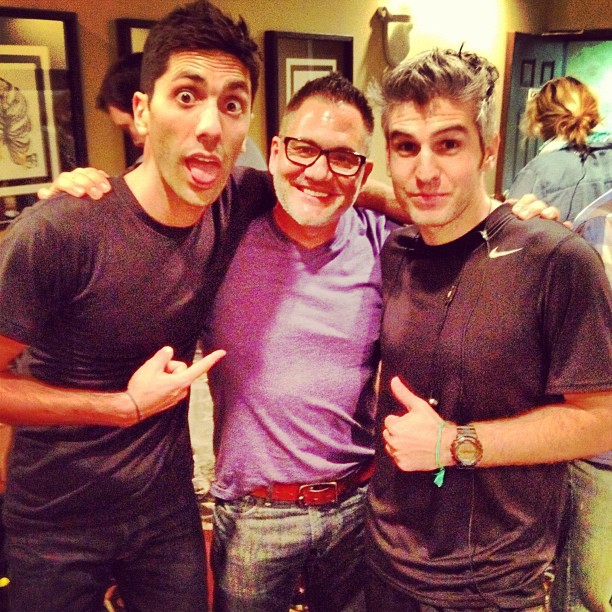
 RSS Feed
RSS Feed